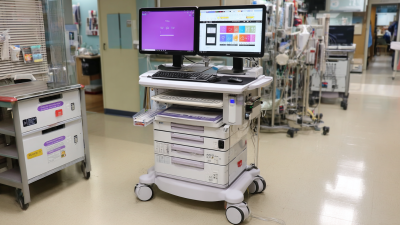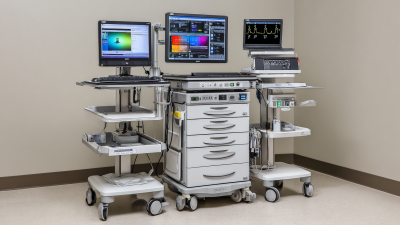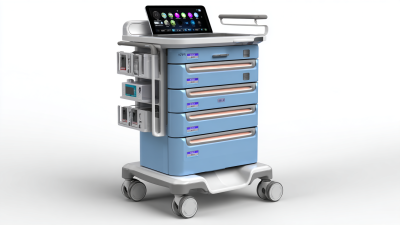Maximize Efficiency: Essential Tips for Choosing the Right Medical Computer Cart
In today's fast-paced healthcare environment, the demand for efficiency and productivity has never been higher. A significant aspect of achieving these goals lies in the effective deployment of medical technology, particularly through the use of medical computer carts. According to a recent report by the Healthcare Information and Management Systems Society (HIMSS), nearly 75% of healthcare professionals assert that mobile technology, including medical computer carts, enhances care delivery and patient outcomes. These carts not only facilitate easy access to electronic health records (EHR) but also streamline workflows, ultimately contributing to improved staff satisfaction and reduced administrative burdens. As healthcare facilities look to optimize their operations, understanding the benefits and choosing the right medical computer cart is essential for maximizing efficiency and ensuring high-quality patient care.

Key Factors to Consider When Selecting a Medical Computer Cart for Enhanced Workflow Efficiency
When selecting a medical computer cart, several key factors must be considered to enhance workflow efficiency. According to the Research and Markets report on healthcare IT solutions, the global market for mobile health IT systems is expected to grow at a CAGR of 25.3% from 2021 to 2026. To keep pace with this rapid growth, healthcare facilities must invest in computer carts that are not only mobile but also designed to support healthcare professionals in providing timely care to patients.

One significant aspect is ergonomics. A study published in the Journal of Occupational and Environmental Medicine indicates that ergonomic workstations can improve productivity by up to 20%. Medical computer carts should be adjustable and designed for comfort, allowing healthcare providers to work efficiently without experiencing fatigue. Additionally, battery life is crucial; the 2022 HIMSS report highlighted that 62% of healthcare workers encounter battery failures with their carts, which can lead to interruptions in patient care. Therefore, choosing a cart with reliable power sources ensures uninterrupted access to patient information at the point of care, ultimately enhancing workflow efficiency.
Comparative Analysis of Fixed vs. Mobile Medical Computer Carts in Clinical Settings
When it comes to enhancing efficiency in clinical settings, choosing between fixed and mobile medical computer carts is a crucial decision. Fixed carts provide stability and a permanent solution for workstations, ideal for environments where a set space is designated for patient data management. They often come equipped with larger screens and more robust computing capabilities, making them suitable for specialists who require a powerful setup. However, the limitation lies in their lack of mobility, which can hinder staff from easily relocating for patient interactions.
On the other hand, mobile medical computer carts offer remarkable flexibility. These carts can be easily maneuvered from room to room, allowing healthcare professionals to bring technology directly to the patient. This mobility enhances workflow efficiency, reduces time spent on transferring patient records, and improves overall patient care. One tip when selecting a mobile cart is to ensure it has a durable design with adequate battery life, as this will support extended use across various shifts.
Ultimately, the choice between fixed and mobile carts should be guided by the specific needs of the clinical environment. Assessing patient flow, space constraints, and the nature of tasks being performed will help determine which type of cart maximizes efficiency for your setting. Consider the layout of your facility and how the cart will be utilized to ensure it aligns seamlessly with your operational workflow.
Impact of Ergonomics on Healthcare Provider Productivity in Using Medical Carts
When it comes to enhancing productivity in healthcare settings, the role of ergonomics cannot be overstated, particularly in the use of medical computer carts. A well-designed medical cart not only supports the physical health of healthcare providers but also significantly influences their workflow efficiency.

Carts that are adjustable and customizable to fit the unique needs of each user can minimize strain and prevent injuries, enabling providers to focus on patient care rather than discomfort or fatigue.
Moreover, ergonomic considerations extend beyond physical design to include the organization of equipment and technology on the cart. By positioning frequently used tools and devices within easy reach, healthcare workers can reduce the time spent searching for supplies or adjusting equipment.
This streamlined approach not only speeds up daily tasks but also allows providers to allocate more time to direct patient interactions, ultimately enhancing the overall quality of care. Investing in ergonomically optimized medical carts is therefore crucial for fostering a more productive and effective healthcare environment.
Evaluating Battery Life and Power Options: What Medical Professionals Should Know
When selecting the right medical computer cart, one of the most critical factors to consider is battery life and power options. Healthcare professionals operate in fast-paced environments where accessibility and reliability are paramount. A cart equipped with a high-quality battery not only ensures that vital medical equipment remains powered throughout long shifts but also enhances workflow efficiency. Recent studies highlight the importance of integrating renewable energy solutions to reduce dependence on conventional power sources. Implementing such strategies in medical settings can pave the way for more sustainable operations, thereby minimizing the carbon footprint.
Furthermore, evaluating the state of health of batteries is essential for maintaining the reliability of medical carts. Just as advancements in battery technology are improving electric vehicles, similar assessments can be applied to medical equipment. Regular monitoring of battery performance can prevent unexpected failures, ensuring that healthcare professionals can trust their equipment during critical moments. By prioritizing robust battery features and evaluating the life cycle of energy resources, medical facilities can enhance their operational efficiency while supporting a more eco-friendly approach to healthcare.
Maximize Efficiency: Essential Tips for Choosing the Right Medical Computer Cart
| Feature | Description | Recommended Options |
|---|---|---|
| Battery Life | The duration the cart can operate on a single charge | 6-12 hours depending on usage |
| Power Options | Type of power sources available for the cart | Rechargeable batteries, AC power |
| Weight | The overall weight of the medical computer cart | 40-70 lbs for optimum mobility |
| Size | Dimensions of the cart, affecting storage and mobility | Compact designs (24" x 18") are preferable |
| Ergonomics | Design features that enhance user comfort | Adjustable height, easy maneuverability |
| Durability | How well the cart withstands daily use and harsh conditions | Recommended materials: Aluminum, Steel |
| Cost | The price range of medical computer carts | $500 - $1500 depending on features |
The Importance of Mobility Features in Medical Carts: A Comparison of Top Brands
In the ever-evolving healthcare landscape, the importance of mobility features in medical carts cannot be overstated. Medical professionals often operate in fast-paced environments that demand quick access to information and equipment. Carts equipped with superior mobility features, such as swivel wheels, lightweight designs, and ergonomic handles, allow healthcare workers to navigate through crowded spaces with ease. This not only enhances workflow efficiency but also minimizes the risk of accidents, ensuring a safer environment for both patients and staff.
When comparing top brands, it becomes evident that features like adjustable height and flexible configurations significantly contribute to the usability of medical carts. For instance, brands that offer carts with pneumatic lifts enable seamless height adjustments, accommodating various user preferences and reducing strain during prolonged use. Furthermore, the integration of advanced technology, such as built-in charging stations for devices, further enhances the functionality of these carts. As healthcare systems prioritize patient care and staff efficiency, investing in a medical cart with the right mobility features can make a significant difference in daily operations.
Related Posts
-

Innovative Solutions for the Future of Medical Computer Carts in Healthcare Environments
-

Ultimate Guide to Choosing the Best Medical Computer Cart for Your Facility
-

Top Strategies for Choosing the Best Medical Trolley Cart for Your Facility
-

How to Choose the Best Mobile Medical Cart: 5 Key Features for Enhanced Patient Care
-

Innovative Solutions for Your Medical Trolley with Drawers to Enhance Healthcare Efficiency
-

The Ultimate Guide to Choosing the Perfect Stainless Steel Medical Cart for Your Healthcare Facility
